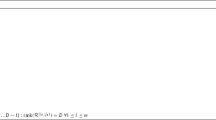Abstract
Fix a field \(\mathbb {F}\). The algebraic immunity over \(\mathbb {F}\) of boolean function f : {0, 1}n → {0, 1} is defined as the minimal degree of a nontrivial (multilinear) polynomial \(g(x) \in \mathbb {F}[x_{1}, \ldots , x_{n}]\) such that f(x) is a constant (either 0 or 1) for all x ∈ {0, 1}n satisfying g(x) = 0. Function f is called k r o b u s t i m m u n e if the algebraic immunity of f is always not less than k no matter how one changes the value of f(x) for k ≤ |x| ≤ n − k. For any field \(\mathbb {F}\), any integers n, k ≥ 0, we characterize all k robust immune symmetric boolean functions in n variables. The proof is based on a known symmetrization technique and constructing a partition of nonnegative integers satisfying certain (in)equalities about p-adic distance, where p is the characteristic of the field \(\mathbb {F}\).
Similar content being viewed by others
Notes
By nontrivial, we mean there exists some x ∈ {0, 1}n such that g(x) = 0.
f g = 0 should be understood semantically, i.e., for every x ∈ {0, 1}n, f(x)g(x) = 0; alternatively, f g = 0 could be understood as multiplication of polynomials over the quotient ring \(F[x_{1}, \ldots , x_{n}]/({x_{1}^{2}} = x_{1}, \ldots , {x_{n}^{2}} = x_{n})\).
The rows are indexed by subsets of [n] of size ≤ d, the columns are indexed by points x ∈ {0, 1}n such that f(x) = 1, and the entry (S, x) is exactly \({\prod }_{i \in S} x_{i}\).
The converse is not true, that is, there are 2k-variable symmetric boolean functions with maximum algebraic immunity k which are not k robust immune. However, they are “close” to some k robust immune functions.
The computation consists of some simple manipulations reducing to Vandermonde matrix.
Or equivalently, embed \(\mathbb {Z}_{\ge 0}\) into the ring of p-adic integers \(\mathbb {Z}_{p}\), which is a formal series \(x = {\sum }_{i \ge 0} x_{i} p^{i}\).
In the following inequality, we could have written x instead of x ≥ i + 1. We are denoting the variable by x ≥ i + 1 for bit alignment.
In abuse of notation, the term (1i, 0, ?e − 1 − i, x ≥2) means the sum over all 01 strings by replacing ? by 0 or 1.
References
Alekhnovich, M., Razborov, A.: Lower bounds for polynomial calculus non binomial case. In: 42nd IEEE Symposium on Foundations of Computer Science, pp. 190–199 (2001)
An, B., Preneel, B.: On the algebraic immunity of symmetric boolean functions. In: Progress in Cryptology—Indocrypt 2004, LNCS 3797, pp. 35–48 (2005)
Beck, C., Li, Y.: Represent MOD function by low degree polynomial with unbounded one-sided error. arXiv:http://arxiv.org/abs/1304.0713 (2013)
Carlet, C., Dalai, D. K., Gupta, K. C., Maitra, S.: Algebraic immunity for cryptographically significant boolean functions: analysis and construction. IEEE Trans. Inf. Theory 52(7), 3105–3121 (2006)
Carlet, C., Feng, K.: An infinite class of balanced functions with optimum algebraic immunity, good immunity to fast algebraic attacks and good nonlinearity. In: Proceedings of ASIACRYPT 2008, LNCS 5350, pp. 425–440 (2008)
Courtois, N. T., Meier, W.: Algebraic attacks on stream ciphers with linear feedback. In: Advances in Cryptology—EUROCRYPT 2003, LNCS 2656, pp. 346–359 (2003)
Chaudhuri, S., Radhakrishnan, J.: Deterministic restrictions in circuit complexity. STOC 96: Proceedings of the twenty-eighth annual ACM symposium on Theory of computing, pp 30–36. ACM Press (1996)
Green, F.: A complex-number Fourier technique for lower bounds on the Mod-m degree. Comput. Complex. 9(1), 16–38 (2000)
Kopparty, S., Srinivasan, S.: Certifying polynomials for AC0[ ⊕] circuits, with applications. In: 32nd Intl Conference on Foundations of Software Technology and Theoretical Computer Science (FSTTCS 2012), pp. 36–47
Liu, F., Feng, K.: Efficient computation of algebraic immunity of symmetric boolean functions. LNCS 4484, 318–329 (2007)
Na, L., Qi, W.: Symmetric boolean functions depending on an odd number of variables with maximum algebraic immunity. IEEE Trans. Inf. Theory 52(5), 2271–2273 (2006)
Pasalic, E.: A design of boolean functions resistant to (fast) algebraic cryptanalysis with efficient implementation. Cryptogr. Commun. 4(1), 25–45 (March 2012)
Peng, J., Quanshui, W., Kan, H.: On symmetric boolean functions with high algebraic immunity on even number of variables. IEEE Trans. Inf. Theory 57(10), 7205–7220 (2011)
Longjiang, Q., Li, C.: On the 2m-variable symmetric boolean functions with maximum algebraic immunity. Sci. China Ser. F: Inf. Sci. 51(2), 120–127 (2008)
Tang, D., Carlet, C., Tang, X.: Highly nonlinear boolean functions with optimal algebraic immunity and good behavior against fast algebraic attacks. IEEE Trans. Inf. Theory 59(1), 653–664 (2013)
Wang, Hui, Peng, Jie, Li, Yuan, Kan, Haibin: On 2k-variable symmetric boolean functions with maximum algebraic immunity k. IEEE Trans. Inf. Theory 58(8), 5612–5624 (2012)
Author information
Authors and Affiliations
Corresponding author
Rights and permissions
About this article
Cite this article
Li, Y. Characterization of robust immune symmetric boolean functions. Cryptogr. Commun. 7, 297–315 (2015). https://doi.org/10.1007/s12095-014-0120-7
Received:
Accepted:
Published:
Issue Date:
DOI: https://doi.org/10.1007/s12095-014-0120-7




